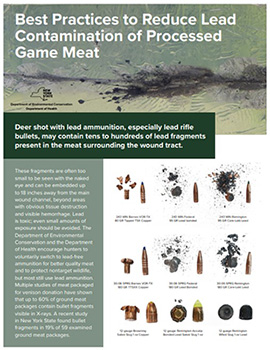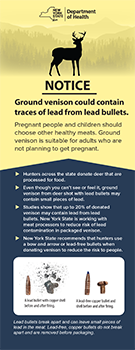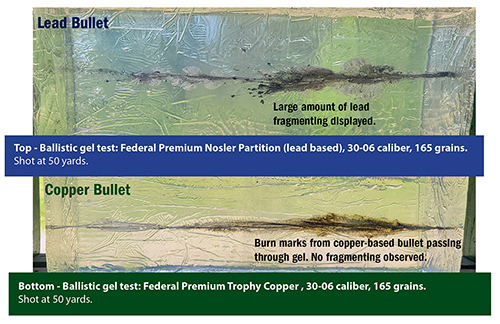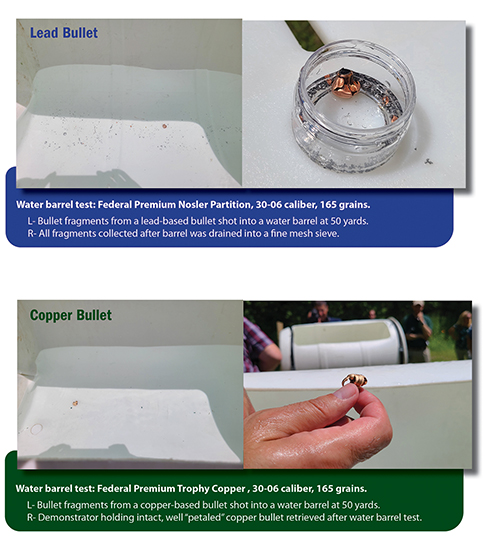Hunting provides contact with nature, healthy exercise, and locally-sourced food that is delicious and nutritious! New York State hunters enjoy a variety of game such as deer, bear, rabbit, turkey, ducks, geese, squirrel, and more. Before you head out, make sure you have your New York State hunting license and education requirements and follow the tips below for safely handling and preparing harvested animals.
Good Sanitary Practices
Follow these good sanitary practices to minimize the risk of bacteria and diseases when handling or processing animals.
Do not handle or eat game or waterfowl that appear sick, act strangely, or are found dead. Handling animals with suspected diseases like rabies or CWD should be avoided and meat from infected game should never be eaten.
Hand and Tool Hygiene
- Wear nitrile, rubber or latex gloves when field dressing, skinning, and butchering game.
- It’s especially important to wear gloves when your hands have cuts or open sores.
- Wash hands, tools and work surfaces with soap and water before handling any raw food, including game meat.
- After butchering, wash tools, work surfaces, and your hands, arms or other exposed body parts thoroughly with soap and water.
- Rinse tools and work surfaces with either boiling water (212°F) or sanitize with a bleach solution or chemical sanitizer.
- Butchering tools should never be used for any other purpose. Keep butchering tools separate from utensils regularly used in the kitchen.
When Using Bleach
- Always a fresh bleach/water solution by following the product label directions.
- Never mix bleach with ammonia or other chemicals. It can cause toxic gases.
- Always wear nitrile, rubber or latex gloves when handling bleach and avoid getting it in eyes, skin or clothing.
- When there is contact, immediately wash affected areas with water and remove affected clothing.
- Use bleach in well ventilated areas because it may cause eye, nose, or throat irritation.
Special Precautions for Diseases Affecting Game Animals
E.coli
Escherichia coli (E. coli) are bacteria found in the environment, food, and intestines of people and animals and can cause severe illness in humans. It can be spread through contaminated water and food. E. coli infection can be prevented by using proper butchering techniques that avoid contact with intestinal contents, and by cooking meats to the above recommended cooking temperatures.
Rabies
Rabies is a viral infection that quickly attacks an animal's nervous system and can lead to paralysis and death, within several days after signs of disease. Rabies can be found in any mammal (especially raccoons, bats, skunks, foxes). It is only found occasionally in New York State deer.
Rabid animals may:
- seem to lose their normal fear of humans
- salivate excessively
- appear to have injured hind legs
- or be found lying on the ground struggling
Rabies can be transmitted from infected mammals to humans through contact with infected tissues and fluids, particularly nervous tissue and saliva. Treatment can prevent rabies from developing in exposed humans. Rabies is almost always fatal in exposed humans who develop the disease.
Avoid handling rabid animals and do not eat meat from infected game.
Toxoplasmosis
Toxoplasmosis is an infection caused by the parasite Toxoplasma gondii which is commonly found in the environment. Toxoplasmosis can be spread by eating undercooked, contaminated meat such as venison, unwashed fruits and vegetables, and unpasteurized milk.
While people infected with Toxoplasmosis often have no or mild flu-like symptoms, pregnant women and those with compromised immune systems can experience serious health problems, including stillbirth and death. To prevent the risk of Toxoplasmosis and other infections from food, cook meats to the above recommended cooking temperatures.
Chronic Wasting Disease
CWD is a brain infection of deer and elk that leads to:
- loss of body functions
- poor body condition
- abnormal behavior such as staggering or very poor posture
- eventual death of the animal
It has been present for several years in Western and mid-Western states and some Canadian provinces. No cases of CWD have been detected in New York State since 2005 when it was found in captive and wild white-tailed deer. When hunting in a region where it is more common, take these additional precautions when butchering and preparing game.
- The brain, spinal cord and other nervous tissue, spleen, pancreas, eyes, tonsils, and lymph nodes of game may have abnormal infectious proteins called CWD prions. Other organs (liver, kidney, heart and salivary glands) may also pose a risk of infection.
- Normal field dressing will eliminate most of these organs and tissues. Lymph nodes can be eliminated by boning out the meat and carefully trimming the fat and connective tissue.
- Soak cleaned knives and tools for one hour in a fresh solution of household chlorine bleach (unscented) mixed with an equal amount of water (for example, 1-quart bleach with 1-quart water), air dry, then rinse with clean water.
- Wipe down cleaned counters and other surfaces with the bleach solution and allow them to air dry.
Cooking does not remove the risk of CWD. However, there is currently no evidence that CWD in animals is linked to disease in people.
More Information
Lead Ammunition
Lead is highly toxic; there is no known safe level of lead exposure for children or adults. Game harvested with lead bullets are of greatest concern for young children and people who can get pregnant.
Ballistic studies show that lead bullets shatter into small pieces upon impact and may contaminate meat. These pieces can be too small to detect by sight, feel, or even when eating.
The best way to avoid lead exposure from eating game is to use non-lead ammunition or consider bow hunting. This is especially important if you are donating game meat. See more information about donating venison.
Using non-lead ammunition also reduces risk to other wildlife (particularly bald eagles) which may consume contaminated meat or viscera from gut piles or wounded animals not found by hunters.
Lead accumulates in the human body over a lifetime, and it is released very slowly. For adults, health effects could be occurring from lead at very low levels of exposure, even if people don’t observe symptoms. People who can get pregnant, who are breastfeeding, and caregivers should carefully consider the potential risks of eating game harvested with lead ammunition on children. Because of these risks, DOH recommends that children and people who can get pregnant should not eat game meat that was harvested using lead ammunition. Talk with your health care provider or email us to learn more.
Choosing non-lead ammunition yields better meat (links to DEC website). Non-lead ammunition typically remains more intact, creates a smaller wound channel and reduces contamination from fur, dirt, bone, etc. Visit DEC's Best Practices to Reduce Lead Contamination of Processed Game Meat (pdf) for more information.
Lead Versus Copper Amunition
Images from Lead and Non-lead Demo
Hosted by the Department of Environmental Conservation and North American Non-lead Partnership at the Saratoga CCE 4H Shooting Sports Center.
The path and fragmentation of premium lead and non-lead bullets of the same caliber were compared by being shot into water barrels and ballistic gel.
Click to view larger versions of these images.
Images from a ballistic gel test
Images from a water barrel test
Processing Tips for Reducing Exposure from Lead-Shot Game
-
Discard meat with excessive bullet damage. Trim a generous distance away from bullet wound channels and discard bruised or discolored meat, as well as meat contaminated with fur, dirt, bone fragments or plant material.
-
If using a commercial processor, ask them to process your deer separately from others and request they trim generously around the wound channel.
-
Ground meat from lead-shot game tends to contain more lead fragments than whole muscle cuts. If you grind, clean your meat grinder regularly.
Additional Resources
Learn more about the best practices when processing deer to minimize risks of lead contamination (DEC publication, PDF).

Ground venison could contain traces of lead from lead bullets. Learn more about DOH recommendations for families (pdf).

People can be exposed to lead from shooting at indoor and outdoor firing ranges. Learn how to reduce your exposure (pdf).

Waterfowl and Snapping Turtles
NYS DOH issues health advice about limiting the amount of waterfowl and snapping turtles you eat because of chemical contamination.
Note: The use of lead shot for waterfowl hunting is prohibited in New York State, and waterfowl hunters are required to use NYS DEC approved non-lead shot alternatives.
Wild Waterfowl (Contaminants: PCBs, mirex, chlordane, DDT)
| Waterfowl |
Advice for Everyone |
| Mergansers |
DON’T EAT |
| All other waterfowl |
Up to 2 meals/month |
Tips for Reducing Exposures:
Wood ducks and Canada geese are better choices than other wild waterfowl because they have lower contaminant levels. Dabbler ducks, which accumulate less chemicals, are a better choice than diving ducks.
Skin and remove all fat before cooking, and discard stuffing after cooking.
Special Advice for Hudson River Waterfowl due to PCBs
-
Avoid harvesting waterfowl from the Hudson River between Hudson Falls (Washington County) and Troy (Rensselaer County) due to PCBs. Instead harvest your waterfowl from other areas on the Hudson River or other waters.
-
In all other waters, harvest waterfowl during the early season when many birds are likely to be resident waterfowl (non-migratory).
-
Because PCBs may have a greater effect on young children or the unborn child, it is particularly important for women under 50 and children under 15 to follow this advice and minimize their PCB exposures.
Snapping Turtles (Contaminants: PCBs)
| Population |
Advice |
Sensitive population: Women of childbearing
years and children |
DON’T EAT |
| General population: Everyone else |
Avoid eating snapping turtles that come from
a waterbody with PCB advisories for fish |
Tips for Reducing Exposures:
Reduce your exposure by carefully trimming away and discarding all fat, liver and eggs prior to cooking the meat or preparing soup.
Snapping turtles retain contaminants in their fat, liver, eggs and, to a lesser extent, muscle.
How to Handle Harvested Game
View these videos from Purdue Extension for best wild game harvest practices.
Warning: this content can be disturbing to some viewers and is intended for educational purposes.
Recipes and Food Preservation
Eating locally-sourced wild game can be an excellent choice for the whole family. Check out these great recipes for venison meatballs, duck kabobs, and roasted wild turkey, from Wild Harvest Table.
Ways to process and store meat for future use: Proper Processing of Wild Fish & Game
More Information & Contacts
NYS Department of Health
Bureau of Toxic Substance Assessment
- More information about game advisories:
518-402-7800, btsa@health.ny.gov
Bureau of Occupational Health and Injury Prevention
- More about lead exposure:
518-402-7500, bohip@health.ny.gov
Bureau of Community Environmental Health and Food Protection
- More information about safe food preparation:
518-402-7900, bcehfp@health.ny.gov
NYS Department of Environmental Conservation
NYS Department of Agriculture and Markets
Information on venison donation programs and where to find processors:





